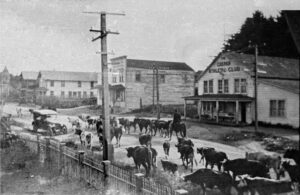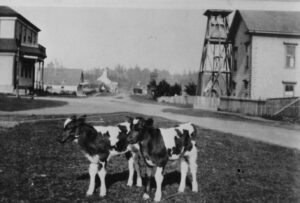Cattle Invade Garage
This odd headline appeared on the front page of the Oct 13, 1928 edition of the Mendocino Beacon. The story goes on to say, “A band of some 60 head of dairy cows being driven up the coast were going through Mendocino and when passing the S. & E. Garage, spied the big open doors, and evidently taking it for a barn, they rushed in, in a body. They crowded into the show room, back out in the workshop and filled the main floor of the garage, a milling bawling band of bovines.”

Road hazards were different in Mendocino back then. Instead of visitors intent on taking in the sights and becoming oblivious to the cars around them, or bike clubs clotting our main transportation artery, people had to regularly contend with cattle drives up and down Highway 1. At this period in time, the route through town would have been Lansing Street and eastern Main Street. Can you imagine sitting at Good Life Cafe and watching this?
This 1928 event was miniscule in size compared to an earlier drive reported in the Beacon in 1916, when 560 head of cattle were driven through Mendocino, having been herded from Greenwood to Fort Bragg for shipping out on the railroad.
These cattle drives really put into perspective the impediments to travel we encounter today as we travel our coastal highway. That slow RV in front of us, cruising along at a mere 35 miles per hour? Easier to deal with than a cattle drive.

Animals were all around Mendocino back in the day. And not just dogs, our current ubiquitous companions. They grazed the roads to keep vegetation down, and were pastured south of Main as late as the 1960s. There were barns on almost every block, which housed the family milk cows, chickens and rabbits. As late as 1929, when so many people had already converted their barns into sheds for their horse-less carriages, the Sanborn Map Company still showed 17 barns or stables.
Some of these buildings were quite large. Auggie Heeser, owner of the Beacon but also a sheep rancher and potato farmer, had a 1½ story barn that sat near the corner of Little Lake Street and Kasten, on property now occupied by the Art Center. This would have been convenient to the sheep he pastured out on the open lands that we call the Mendocino Headlands.
Not far from the bovine invasion at the S. & E. Garage was another large structure, known as The Company Barn. Over 100 feet in length, it was located behind the now-gone Occidental Hotel, and south of Main Street, if Lansing still continued toward the bluffs. It was built in 1871 as Mendocino’s first skating rink and dance hall, then became a barn for wintering work animals from the woods, and later was used as a bark mill and storage shed. It burned to the ground in 1936.
Indeed, the Occidental Hotel’s own barn was located right where the cows “came home” in 1928. This large livery-feed & storage stable opened in 1880, and had an attached carriage house that would have functioned just like today’s hotel parking garages. Next to it stood a 2-tank water tower and windmill 50 feet tall, higher than just about anything else nearby, except the Presbyterian Church’s 78-foot high steeple. By 1909, maps no longer show a barn or a carriage house, probably because horses were being used less frequently by the traveling public.
Which brings us back to the building invaded by those 60 cows. Where once there stood a hotel barn, a new building was constructed in 1914 by Ray Valentine for the Fort Bragg Garage and Machine Company. It was much-appreciated because it was “Mendocino’s first fire proof building,” using corrugated iron siding instead of the usual wood. The parcels associated with this garage went through several ownerships, and the business name changed from the B. & B. Garage (Bowman and Boyle), to the S. & E. Garage (Sutherland and Escola). There was a showroom and sales office for Plymouth, DeSoto, Whippet cars, and International trucks. Ralph Sutherland came into the picture in 1932, changing the name to Sutherland’s Garage, and a new gas station and service station were constructed in 1936 just east of the original building. Delbert Schlafer, who had previously worked at the S. & E. Garage, took over management in 1951 and eventually bought it. Schlafer’s garage has remained in that family since.
So, what happened to the rampaging cows? The article relates a favorable outcome: “One of the employees, who has lived on a ranch and knows how to handle cows, slipped into the show room with a wad of hay in his hand and the critters all followed him out without doing any pecuniary damage. The employees nearly had heart failure before the excitement was over and the critters had taken their departure.” What a relief!